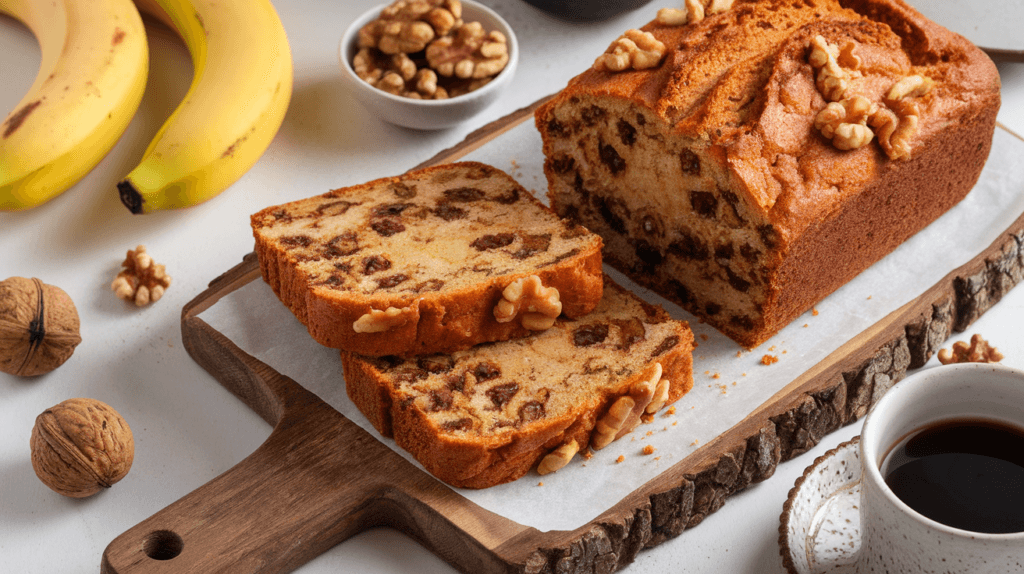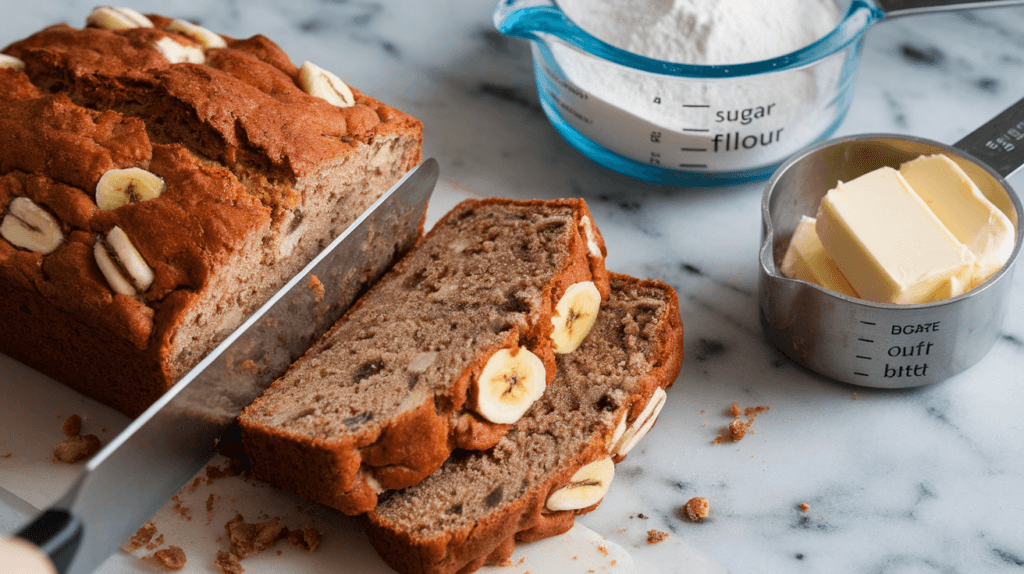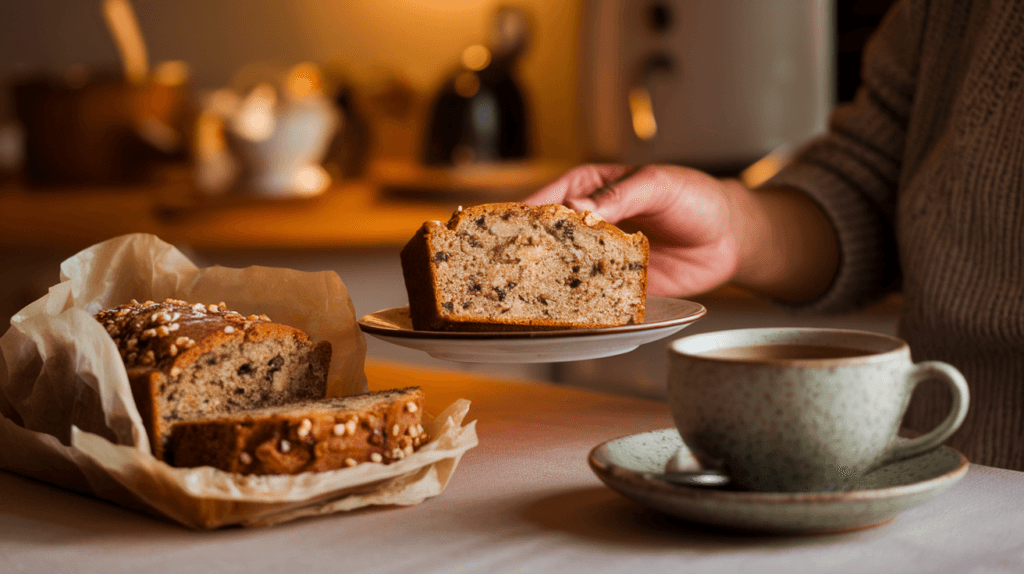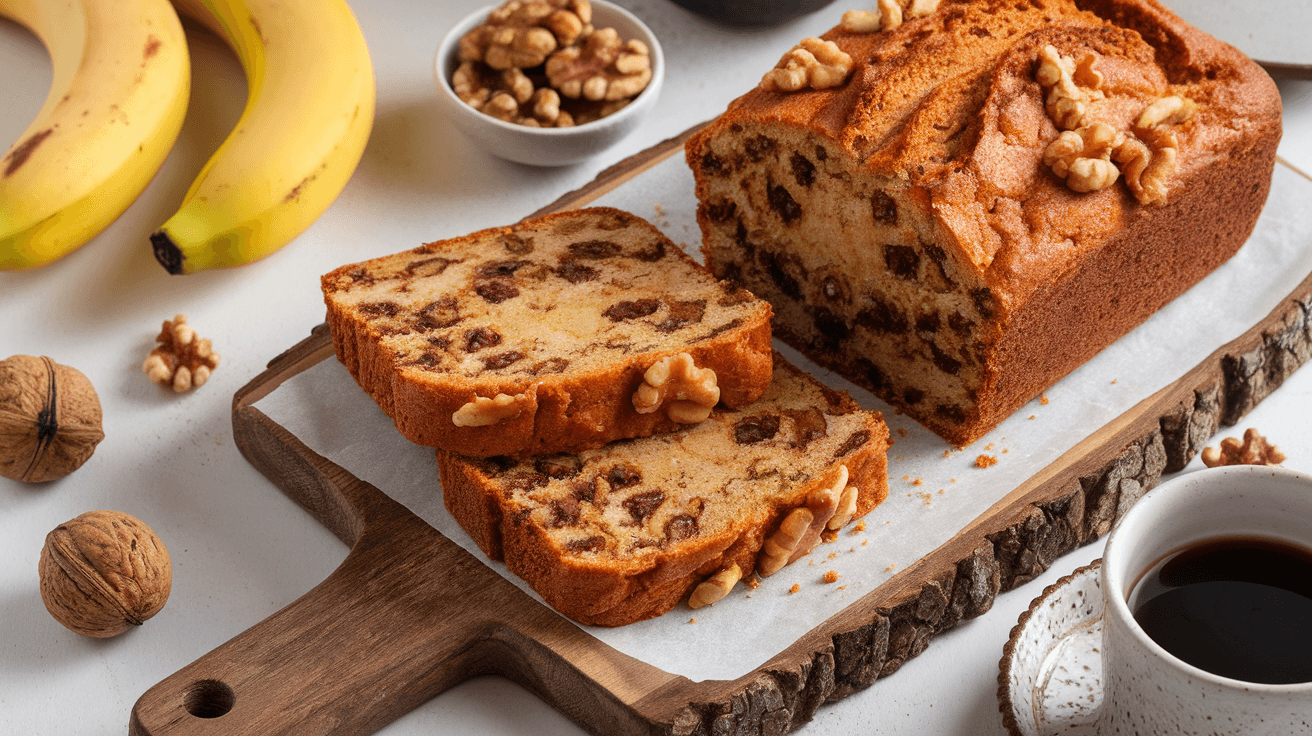Introduction
Banana nut bread is a delicious treat enjoyed by many, whether as a quick breakfast, a snack, or even a dessert. However, like many baked goods, it is essential to understand its nutritional content, particularly its calorie count. If you’re wondering how many calories are in 2 slices of banana nut bread, you’re not alone. This popular quick bread combines ripe bananas and nuts, making it both flavorful and energy-dense. Knowing how many calories are in 2 slices of banana nut bread can help you maintain a healthy diet and track your daily intake. In this article, we’ll dive into the typical calorie count for banana nut bread, explore factors that affect its nutritional value, and provide tips on making healthier versions at home.

What Is Banana Nut Bread?
Definition and Ingredients
Banana nut bread is a moist, flavorful quick bread made with ripe bananas and often enriched with chopped nuts like walnuts or pecans. The recipe may also include ingredients such as flour, sugar, eggs, butter, or oil, and baking soda for leavening.
A Brief History
This beloved recipe became widely popular during the 20th century as home bakers sought creative ways to use overripe bananas. The addition of nuts added crunch and flavor, turning a simple bread into a comforting, crowd-pleasing dish.
Calorie Count in Banana Nut Bread
How Calories Are Calculated in Banana Nut Bread
The calorie content in banana nut bread depends on the ingredients used and the portion size. Key ingredients such as bananas, flour, sugar, butter, and nuts significantly contribute to how many calories are in 2 slices of banana nut bread. Each component’s nutritional value per gram or cup is calculated, and the total gives a rough estimate of the loaf’s calorie count. By dividing this total by the number of slices, you can determine how many calories are in a single slice of banana nut bread, or in two slices, depending on your portion size.
For instance, a typical banana nut bread recipe includes:
- 2-3 ripe bananas (about 200 calories)
- 1 cup of sugar (about 774 calories)
- 1/2 cup of butter or oil (about 800 calories)
- 1-2 cups of flour (about 455 calories per cup)
- 1/2 cup of nuts (about 400 calories)
This brings the total calorie count for the loaf to approximately 2,600-3,000 calories, depending on portion sizes and specific brands of ingredients used.
Factors Affecting Calorie Count
Several factors influence the calorie count of banana nut bread:
- Ingredient Variations: Using whole wheat flour instead of all-purpose flour or substituting sugar with a low-calorie sweetener can reduce calories.
- Portion Size: Thicker slices have more calories compared to thinner ones.
- Toppings and Add-ins: Adding chocolate chips, glaze, or extra nuts can significantly increase the calorie content.
How Many Calories Are in 2 Slices of Banana Nut Bread?
Typical Calorie Estimates
The calorie count for two slices of banana nut bread can vary widely based on the recipe, the size of the slices, and whether it is homemade or store-bought. If you’re curious about how many calories are in 2 slices of banana nut bread, the answer typically ranges from 400 to 500 calories for two medium slices. On average, one medium slice of banana nut bread contains about 200-250 calories. This variation in calorie count highlights the importance of understanding the recipe and portion sizes when calculating how many calories are in 2 slices of banana nut bread.
Here’s an approximate breakdown for two medium slices:
- Homemade Banana Nut Bread: 400-450 calories (based on common recipes)
- Store-Bought Banana Nut Bread: 450-500 calories (due to added preservatives and sugars)
- Reduced-Calorie or Diet Versions: 300-350 calories (using alternative ingredients like almond flour or stevia)
It is essential to check nutrition labels on store-bought varieties or calculate the calories in your homemade version based on the ingredients and portion size to get an accurate count.
Homemade vs. Store-Bought Variations
When comparing homemade and store-bought banana nut bread, the latter often has a higher calorie count due to additional ingredients like refined sugars, hydrogenated oils, and artificial flavors. Homemade versions allow you to control the ingredients, making it easier to create a lower-calorie option by using healthier substitutes.
For example:
- Using unsweetened applesauce instead of butter can cut calories by up to 400 per loaf.
- Replacing sugar with natural sweeteners like honey or stevia reduces sugar content significantly.
- Opting for almond flour or oat flour instead of all-purpose flour can reduce carbohydrate levels and increase fiber.
Overall, homemade banana nut bread offers more flexibility to tailor the recipe to your dietary needs and calorie goals.
Nutritional Breakdown of Banana Nut Bread

Macronutrients: Carbs, Fats, and Proteins
In addition to its calorie content, banana nut bread contains a balance of macronutrients that contribute to its overall nutritional profile. Here’s a typical breakdown for two medium slices (about 400-500 calories):
- Carbohydrates: Approximately 60-70 grams, depending on the sugar and flour content. Bananas and flour are the primary sources of carbohydrates.
- Fats: Around 15-20 grams, primarily from butter, oil, and nuts. These fats include healthy unsaturated fats from the nuts and saturated fats from butter.
- Protein: About 5-8 grams, coming from eggs and nuts. While not a significant source of protein, the addition of nuts increases the overall protein content.
This macronutrient composition makes banana nut bread an energy-dense food, suitable as a snack or a meal accompaniment. However, portion control is vital to avoid excessive calorie intake.
Vitamins and Minerals
Banana nut bread also contains essential vitamins and minerals, primarily derived from the bananas and nuts:
- Potassium: Bananas are rich in potassium, an essential mineral that supports heart health and muscle function. Two slices may provide 300-400 mg of potassium.
- Vitamin B6: Present in bananas, this vitamin supports brain development and immune function.
- Magnesium: Found in nuts, magnesium aids in bone health and energy production.
- Fiber: The bread contains about 2-4 grams of dietary fiber, which supports digestive health. Using whole grain or alternative flours can increase the fiber content.
Health Considerations
While banana nut bread can provide beneficial nutrients, its high sugar and fat content can make it less suitable for individuals managing their weight, blood sugar levels, or cholesterol. Opting for healthier recipes or enjoying it in moderation can help maintain a balanced diet.
How to Make Healthier Banana Nut Bread
Healthier Ingredient Substitutions
Making banana nut bread healthier is all about substituting calorie-dense ingredients with nutrient-rich alternatives. Here are some ideas:
- Replace Sugar: Use natural sweeteners like honey, maple syrup, or mashed dates instead of refined sugar. Alternatively, try a zero-calorie sweetener like stevia.
- Swap Butter or Oil: Substitute with unsweetened applesauce, Greek yogurt, or mashed avocado to reduce fat and calorie content.
- Use Whole-Grain Flour: Replace all-purpose flour with whole wheat, almond, or oat flour to add fiber and nutrients while reducing the glycemic index.
- Add Nutrient Boosters: Mix in chia seeds, flaxseeds, or a handful of dried fruit to increase the fiber and vitamin content.
These substitutions not only lower the calorie count but also enhance the nutritional value of your banana nut bread.
Portion Control Tips
Portion control is crucial when enjoying calorie-dense treats like banana nut bread. Here are some tips to help you manage serving sizes:
- Slice Thinly: Cut the bread into smaller slices to reduce calories per serving while still satisfying your craving.
- Freeze Portions: Wrap individual slices in plastic wrap and store them in the freezer. This prevents overeating and makes for a convenient snack.
- Pair with Healthy Sides: Enjoy your bread with a source of protein, such as a dollop of Greek yogurt, to balance the meal and stay fuller for longer.
By following these strategies, you can still indulge in banana nut bread without compromising your health goals.
Banana Nut Bread and Its Role in a Balanced Diet
Is Banana Nut Bread a Healthy Option?
Banana nut bread can be a part of a balanced diet when consumed in moderation and paired with other nutritious foods. While it is not traditionally considered a “health food” due to its sugar and fat content, it provides valuable nutrients such as potassium, magnesium, and dietary fiber. Its versatility makes it suitable for breakfast, a snack, or even a dessert.
How to Incorporate Banana Nut Bread in a Balanced Diet
To enjoy banana nut bread without compromising your health goals, consider these tips:
- Pair with Protein: Add a side of Greek yogurt or a boiled egg to balance the meal and stay fuller for longer.
- Control Portions: Stick to one slice per serving and avoid extra toppings like butter or cream cheese to reduce calorie intake.
- Choose Healthier Recipes: Opt for homemade versions with healthier ingredient swaps to ensure better nutritional value.
Banana Nut Bread for Special Diets
With simple adjustments, banana nut bread can cater to a variety of dietary needs:
- Low-Calorie Diet: Use low-calorie sweeteners and replace oil with applesauce to reduce calories.
- Keto Diet: Use almond flour, erythritol as a sweetener, and omit bananas to create a low-carb alternative.
- Vegan Diet: Swap eggs with flaxseed meal and butter with coconut oil for a vegan-friendly option.
When to Enjoy Banana Nut Bread?
Timing is key when including banana nut bread in your diet:
- As a Pre-Workout Snack: Its carbs provide quick energy for physical activity.
- As a Midday Treat: A single slice can satisfy sweet cravings and prevent overeating later.
- Post-Workout Recovery: Pair it with a protein-rich side to replenish glycogen stores and aid muscle recovery.
Final Thought
Banana nut bread can be part of a nutritious lifestyle when enjoyed mindfully. Its comforting flavor and texture make it a delightful choice for any occasion, provided you balance it with nutrient-dense foods and maintain proper portion sizes.
Fun Facts About Banana Nut Bread
1. The Great Depression Inspired Its Popularity
Banana nut bread rose to fame during the Great Depression in the 1930s. During this period, people were reluctant to waste food, and overripe bananas that might have otherwise been discarded found a new purpose in baking. The availability of baking soda and powder during this era also helped home cooks experiment with “quick bread” recipes that didn’t require yeast, making banana bread a household favorite.
2. There’s a Day Dedicated to Banana Bread
If you love banana nut bread, you’re in luck! February 23rd is celebrated as National Banana Bread Day in the United States. This day honors the classic recipe, giving fans an excuse to bake, share, and enjoy this delicious treat with family and friends.
3. A Recipe with Endless Variations
Banana nut bread is incredibly versatile, with countless variations to suit different tastes and dietary needs. Some popular versions include chocolate chip banana bread, gluten-free banana bread, and even vegan banana nut bread. Modern twists on the recipe have also included exotic add-ins like coconut, dried fruit, or spices such as cinnamon and nutmeg.
4. It’s a Global Favorite
While banana nut bread is widely loved in the United States, it has a global appeal. In tropical regions where bananas are abundant, variations of banana bread are often made with local ingredients and cultural twists. For instance, some Caribbean versions include rum-soaked bananas or a mix of tropical nuts.
5. It’s Not Technically “Bread”
Despite its name, banana nut bread is more closely related to a cake than traditional bread. Its sweet flavor, moist texture, and use of leavening agents like baking soda make it a “quick bread,” which is baked without yeast.
6. A Staple in Baking Competitions
Banana nut bread has long been a popular entry in baking competitions. Its simplicity allows for creative twists, and judges often look for perfect texture, balanced sweetness, and an even distribution of nuts.
7. It’s a Nutrient-Packed Snack
Though calorie-dense, banana nut bread offers some surprising health benefits. Bananas provide potassium and vitamin B6, while nuts add healthy fats, fiber, and protein. Many bakers have also adapted traditional recipes to include whole-grain flours, reducing sugar and fat to make it even healthier.
8. It’s a Celebrity Favorite
Banana nut bread has even found its way into celebrity culture. Many famous chefs and personalities have shared their own versions of the recipe, with unique twists that reflect their tastes. Some celebrities have even gone viral on social media with their banana bread creations during moments like the COVID-19 pandemic when baking became a popular pastime.
9. Perfect for All Seasons
Banana nut bread is a year-round treat that adapts well to seasonal changes. In summer, it pairs wonderfully with fresh fruit or ice cream. In winter, it’s a comforting snack served warm with a cup of tea or coffee. No matter the season, it’s always a hit!
10. A Fun Baking Project for All Ages
One of the reasons banana nut bread remains a favorite is its simplicity. It’s an easy recipe that even beginners or children can try, making it a fun family activity. With minimal ingredients and straightforward steps, it’s a fail-proof recipe that yields delicious results every time.
From its humble origins during the Great Depression to its status as a beloved staple worldwide, banana nut bread continues to be a heartwarming treat with fascinating stories behind it. Next time you enjoy a slice, remember the rich history and creative potential behind this classic recipe!
FAQs

How do I reduce calories in banana nut bread?
To reduce calories, use low-calorie sweeteners, substitute butter with unsweetened applesauce, and opt for whole-grain or almond flour instead of refined flour.
Can I make gluten-free banana nut bread?
Yes, you can use gluten-free flour alternatives like almond flour, coconut flour, or a gluten-free baking mix to create a gluten-free version of banana nut bread.
What is the calorie count of a gluten-free version?
A gluten-free banana nut bread typically contains slightly fewer calories if almond flour is used, averaging about 150-200 calories per slice.
Are there vegan options for banana nut bread?
Yes, substitute eggs with flax eggs or mashed bananas, and use plant-based butter or coconut oil for a vegan-friendly version.
How can I increase the protein content?
Add protein powder, Greek yogurt, or extra nuts to the batter to boost the protein content of your banana nut bread.
Is banana nut bread suitable for diabetics?
Diabetics can enjoy a modified version by using almond flour, a sugar substitute, and limiting portion sizes to control carbohydrate intake.
Conclusion
Banana nut bread is a tasty and versatile treat, but it’s essential to be mindful of its calorie content, especially when enjoying two slices. By understanding its nutritional breakdown and making smart ingredient substitutions, you can enjoy a healthier version of this beloved recipe without sacrificing flavor. Whether homemade or store-bought, portion control is key to incorporating banana nut bread into a balanced diet.

